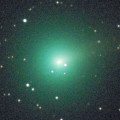
|
Now it is 8.2 mag (Jan. 21, Michael Jager). It will fade out rapidly after this. It stays observable in good condition.
Date(TT) R.A. (2000) Decl. Delta r Elong. m1 Best Time(A, h)
Feb. 3 12 36.82 9 52.6 0.501 1.351 127 8.4 3:47 ( 0, 65)
Feb. 10 12 41.25 9 46.7 0.504 1.383 133 8.7 3:24 ( 0, 65)
|

|
It returns for the first time in 70 years. It will brighten up to 4.5 mag in spring. It suddenly brightened in major outburst by 5 mag up to 11.5 mag on July 20 (E. Tamas, Francois Kugel). It brightened again in another major outburst up to 9.4 mag on Nov. 15 (Nick James). Now it is 8.2 mag (Feb. 1, Osamu Miyazaki). It will brighten rapidly after this. In the Northern Hemisphere, it will be unobservable in April. In the Southern Hemisphere, it is not observable now, but it will appear in April.
Date(TT) R.A. (2000) Decl. Delta r Elong. m1 Best Time(A, h)
Feb. 3 21 30.76 38 15.8 1.898 1.566 55 8.9 18:56 (125, 18)
Feb. 10 22 1.28 38 6.9 1.833 1.473 53 8.6 19:02 (125, 18)
|

|
Now it is 9.8 mag (Jan. 23, Taras Prystavski). Fading slowly. In the Northern Hemisphere, it will be getting higher gradually. In the Southern Hemisphere, it will be getting lower gradually after this, and it will be unobservable in May.
Date(TT) R.A. (2000) Decl. Delta r Elong. m1 Best Time(A, h)
Feb. 3 16 46.71 -25 16.5 1.518 1.332 59 9.4 5:31 (325, 20)
Feb. 10 17 9.68 -20 58.3 1.454 1.322 62 9.2 5:26 (322, 24)
|

|
Now it is 10.0 mag (Feb. 1, Osamu Miyazaki). It will fade out rapidly after this. It stays observable in good condition.
Date(TT) R.A. (2000) Decl. Delta r Elong. m1 Best Time(A, h)
Feb. 3 4 13.79 15 49.1 0.705 1.402 111 10.1 19:23 ( 0, 71)
Feb. 10 4 33.36 16 19.6 0.740 1.410 108 10.1 19:15 ( 0, 71)
|
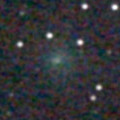
|
Now it is 13.3 mag (Dec. 16, Michael Mattiazzo). It will fade out rapidly after this. It will be fainter than 18 mag in April. In the Northern Hemisphere, it is not observable now, but it will be observable soon. In the Southern Hemisphere, it will be getting higher gradually.
Date(TT) R.A. (2000) Decl. Delta r Elong. m1 Best Time(A, h)
Feb. 3 20 18.22 -34 57.9 1.721 0.872 20 11.9 5:31 (300,-19)
Feb. 10 20 7.90 -33 55.7 1.683 0.919 26 12.5 5:26 (303,-13)
|

|
Now it is 12.7 mag (Jan. 31, Osamu Miyazaki). It stays 13 mag for a while. In the Northern Hemisphere, it stays observable in good condition. It locates somewhat low in the Southern Hemisphere.
Date(TT) R.A. (2000) Decl. Delta r Elong. m1 Best Time(A, h)
Feb. 3 8 17.88 20 33.2 3.201 4.172 168 12.5 23:25 ( 0, 76)
Feb. 10 8 5.50 22 9.3 3.210 4.143 158 12.4 22:45 ( 0, 77)
|

|
It was observed at 9-10 mag for a long time in 2023. Now it is 13.8 mag (Jan. 18, ATLAS South Africa). Fading slowly. In the Northern Hemisphere, it will never be observable after this. It locates somewhat low in the Southern Hemisphere. But it will become high in spring.
Date(TT) R.A. (2000) Decl. Delta r Elong. m1 Best Time(A, h)
Feb. 3 23 28.52 -39 48.4 4.409 3.695 38 12.9 18:56 ( 44, -5)
Feb. 10 23 32.39 -39 36.9 4.499 3.751 36 13.0 19:02 ( 48,-10)
|
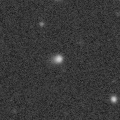
|
It will approach to Sun down to 0.4 a.u. in late September, and it is expected to brighten up to 0 mag. Now it is 13.5 mag (Jan. 21, Michael Jager). It will brighten rapidly after this. It stays observable in good condition. At the high light, in the Northern Hemisphere, it will be observable in good condition after the perihelion passage. In the Southern Hemisphere, it will be observable in the low sky before and after the perihelion passage.
Date(TT) R.A. (2000) Decl. Delta r Elong. m1 Best Time(A, h)
Feb. 3 15 10.79 -7 53.9 3.814 3.870 85 13.3 5:31 (342, 45)
Feb. 10 15 10.99 -7 51.6 3.608 3.787 92 13.1 5:26 (350, 47)
|

|
It approached to Earth down to 0.38 a.u., and brightened up to 8.0 mag in autumn (Sept. 29, Virgilio Gonano). Now it is 13.5 mag (Jan. 15, Toshihiko Ikemura, Hirohisa Sato). It will fade out rapidly after this. It will be fainter than 18 mag in May. It stays observable in good condition.
Date(TT) R.A. (2000) Decl. Delta r Elong. m1 Best Time(A, h)
Feb. 3 8 9.35 -9 41.3 0.868 1.792 150 13.2 23:16 ( 0, 45)
Feb. 10 8 4.30 -7 55.3 0.939 1.854 148 13.6 22:44 ( 0, 47)
|

|
First return of a new periodic comet which brightened up to 10 mag in 2001. It is expected to brighten up to 12-13 mag from February to March. Now it is 16.4 mag (Jan. 11, Toshihiko Ikemura, Hirohisa Sato). Fading gradually. It locates somewhat low in the Northern Hemisphere. In the Southern Hemisphere, it will never be observable after this. Thomas Lehmann reported it was bright as 13.1 mag on Jan. 28.
Date(TT) R.A. (2000) Decl. Delta r Elong. m1 Best Time(A, h)
Feb. 3 23 43.56 15 34.4 1.835 1.439 51 13.7 18:56 ( 87, 33)
Feb. 10 23 52.46 19 36.5 1.862 1.422 48 13.2 19:02 ( 95, 30)
|

|
It brightened up to 8 mag from 2022 summer to 2023 spring. Now it is 13.0 mag (Jan. 31, Osamu Miyazaki). Fading slowly. In the Northern Hemisphere, it will be getting lower gradually after this, and it will be unobservable in May. In the Southern Hemisphere, it stays observable in good condition.
Date(TT) R.A. (2000) Decl. Delta r Elong. m1 Best Time(A, h)
Feb. 3 5 12.66 2 0.1 4.316 4.904 121 13.2 20:21 ( 0, 57)
Feb. 10 5 9.81 3 2.7 4.473 4.965 114 13.4 19:50 ( 0, 58)
|
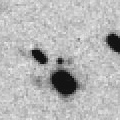
|
It will approach to Earth down to 0.2 a.u. from February to March, and it is expected to brighten up to 13 mag. Now it is 14.6 mag (Jan. 24, ATLAS Chile). It will fade out rapidly after this. It will be fainter than 18 mag in May. It stays observable in good condition. Vladimir Bezugly reported it is visible at around 12 mag in the SOHO LASCO images in late January.
Date(TT) R.A. (2000) Decl. Delta r Elong. m1 Best Time(A, h)
Feb. 3 2 5.72 -16 30.0 0.360 0.939 71 13.5 18:56 ( 29, 33)
Feb. 10 2 40.35 -16 57.0 0.315 0.949 73 13.3 19:02 ( 28, 33)
|

|
Now it is 14.2 mag (Jan. 16, Ken-ichi Kadota). It stays 13 mag for a while. It locates somewhat low in the Northern Hemisphere. In the Southern Hemisphere, it stays observable in good condition. It is expected to brighten up to 12.5 mag in spring. At the high light, it will be observable in excellent condition in the Southern Hemisphere, but it will be low in the Northern Hemisphere.
Date(TT) R.A. (2000) Decl. Delta r Elong. m1 Best Time(A, h)
Feb. 3 15 24.48 -24 55.4 2.746 2.722 78 13.5 5:31 (343, 28)
Feb. 10 15 18.76 -26 44.1 2.594 2.713 86 13.3 5:26 (351, 28)
|

|
Now it is 12.5 mag (Jan. 30, Osamu Miyazaki). It stays observable in good condition.
Date(TT) R.A. (2000) Decl. Delta r Elong. m1 Best Time(A, h)
Feb. 3 8 19.26 21 17.4 5.206 6.175 168 13.5 23:27 ( 0, 76)
Feb. 10 8 15.92 21 22.4 5.236 6.177 160 13.5 22:56 ( 0, 76)
|

|
Now it is 13.7 mag (Jan. 21, Chris Wyatt). Fading slowly. In the Northern Hemisphere, it will be unobservable in May. In the Southern Hemisphere, it stays observable in good condition.
Date(TT) R.A. (2000) Decl. Delta r Elong. m1 Best Time(A, h)
Feb. 3 9 2.57 -45 50.2 4.009 4.546 117 13.7 0:14 ( 0, 9)
Feb. 10 8 47.84 -45 49.5 4.026 4.582 118 13.7 23:26 ( 0, 9)
|

|
Now it is 15.1 mag (Jan. 23, Ken-ichi Kadota). Fading rapidly. It will be fainter than 18 mag soon. It locates somewhat low.
Date(TT) R.A. (2000) Decl. Delta r Elong. m1 Best Time(A, h)
Feb. 3 18 41.98 -13 24.4 1.881 1.201 34 14.1 5:31 (296, 12)
Feb. 10 19 6.35 -11 34.4 1.907 1.241 35 15.1 5:26 (294, 12)
|

|
Now it is 14.5 mag (Jan. 24, ATLAS Chile). It stays 14 mag for a while. It stays extremely low in the Northern Hemisphere. But it will become high in winter. In the Southern Hemisphere, it stays observable in good condition.
Date(TT) R.A. (2000) Decl. Delta r Elong. m1 Best Time(A, h)
Feb. 3 12 14.89 -38 47.1 4.861 5.259 108 14.1 3:26 ( 0, 16)
Feb. 10 12 14.62 -38 53.5 4.759 5.242 114 14.1 2:58 ( 0, 16)
|

|
It brightened up to 7.8 mag in late July (July 20, Thomas Lehmann). Now it is 15.6 mag (Jan. 28, Thomas Lehmann). Fading gradually. It stays observable in good condition.
Date(TT) R.A. (2000) Decl. Delta r Elong. m1 Best Time(A, h)
Feb. 3 15 2.72 0 44.6 2.670 2.851 90 14.2 5:31 (342, 54)
Feb. 10 14 56.04 2 33.9 2.597 2.921 99 14.2 5:26 (354, 57)
|

|
It returned for the first time in 68 years. It will brighten up to 7.5 mag in summer. Now it is 13.6 mag (Feb. 2, Alan Hale). It will brighten rapidly after this. In the Northern Hemisphere, it will be getting lower gradually. In the Southern Hemisphere, it will be getting lower gradually after this, and it will be unobservable in April. At the high light, it locates low in the Northern Hemisphere, or it is not observable in the Southern Hemisphere.
Date(TT) R.A. (2000) Decl. Delta r Elong. m1 Best Time(A, h)
Feb. 3 2 52.03 -5 16.2 2.232 2.373 85 14.5 18:56 ( 21, 48)
Feb. 10 2 53.59 -2 53.1 2.252 2.299 80 14.2 19:02 ( 33, 47)
|

|
It brightened up to 8.3 mag in 2021-2022 winter (Jan. 6, 2022, Toshiyuki Takahashi). Now it is 15.7 mag (Jan. 31, ATLAS Chile). It stays 15 mag for a while. In the Northern Hemisphere, it will be unobservable in May. In the Southern Hemisphere, it stays observable in good condition.
Date(TT) R.A. (2000) Decl. Delta r Elong. m1 Best Time(A, h)
Feb. 3 11 20.23 -52 56.9 6.937 7.242 104 14.3 2:31 ( 0, 2)
Feb. 10 11 16.72 -53 24.7 6.918 7.288 108 14.4 2:00 ( 0, 1)
|
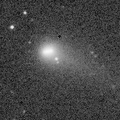
|
Now it is 14.7 mag (Jan. 27, Thomas Lehmann). It stays 15 mag for a while. In the Northern Hemisphere, it stays observable in good condition. It locates somewhat low in the Southern Hemisphere. But it will become high in winter.
Date(TT) R.A. (2000) Decl. Delta r Elong. m1 Best Time(A, h)
Feb. 3 3 3.67 22 3.0 1.793 2.140 96 14.7 18:56 ( 39, 74)
Feb. 10 3 12.35 22 55.9 1.852 2.121 91 14.8 19:02 ( 56, 71)
|
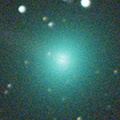
|
It approached to Earth down to 0.2 a.u. in early November, and brightened up to 6.2 mag (Nov. 11, Marco Goiato). Now it is 13.2 mag (Jan. 3, Chris Wyatt). It will fade out rapidly after this. It will be fainter than 18 mag in May. In the Northern Hemisphere, it will never be observable after this. It locates somewhat low in the Southern Hemisphere.
Date(TT) R.A. (2000) Decl. Delta r Elong. m1 Best Time(A, h)
Feb. 3 23 50.42 -43 20.4 2.412 1.838 44 14.8 18:56 ( 39, -5)
Feb. 10 23 59.45 -43 30.9 2.533 1.928 42 15.1 19:02 ( 42, -8)
|

|
It brightened up to 12.1 mag in 2023 spring (May 20, Jose Guilherme de S. Aguiar). Now it is 14.8 mag (Jan. 21, Chris Wyatt). Fading slowly. In the Northern Hemisphere, it is not observable now. In the Southern Hemisphere, it stays observable in good condition.
Date(TT) R.A. (2000) Decl. Delta r Elong. m1 Best Time(A, h)
Feb. 3 3 47.78 -72 6.7 4.111 4.013 77 15.0 18:56 ( 0,-17)
Feb. 10 3 51.62 -69 35.4 4.143 4.054 78 15.1 19:02 ( 3,-15)
|
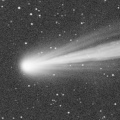
|
It approached to Sun down to 0.23 a.u. and brightened up to 2.5 mag in mid September (Sept. 18, Juan Jose Gonzalez). Now it is 16.4 mag (Jan. 19, Hidetaka Sato). It will fade out rapidly after this. It will be fainter than 18 mag in May. In the Northern Hemisphere, it is not observable now, but it will be observable soon. In the Southern Hemisphere, it stays observable in good condition.
Date(TT) R.A. (2000) Decl. Delta r Elong. m1 Best Time(A, h)
Feb. 3 10 20.47 -57 25.6 2.308 2.720 104 15.2 1:33 ( 0, -3)
Feb. 10 9 54.01 -56 42.4 2.345 2.817 108 15.3 0:39 ( 0, -2)
|
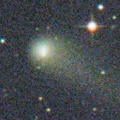
|
It brightened up to 11.1 mag in early 2022 (Mar. 31, 2022, F. Kugel, J.-G. Bosch, J. Nicolas). Now it is 15.1 mag (Jan. 20, Thomas Lehmann). It stays 16 mag for a while. In the Northern Hemisphere, it stays observable in good condition. It locates somewhat low in the Southern Hemisphere.
Date(TT) R.A. (2000) Decl. Delta r Elong. m1 Best Time(A, h)
Feb. 3 17 25.52 19 26.4 6.779 6.418 64 15.4 5:31 (279, 47)
Feb. 10 17 29.77 20 9.9 6.748 6.457 68 15.5 5:26 (281, 51)
|
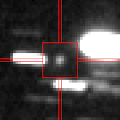
|
It is expected to brighten up to 12.5 mag in summer. Now it is 17.1 mag (Dec. 20, E. Cortes). Brightening gradually. In the Northern Hemisphere, it is not observable now. In the Southern Hemisphere, it stays observable in good condition. Around the high light, it is observable in good condition in the Southern Hemisphere, but it locates very low in the Northern Hemisphere.
Date(TT) R.A. (2000) Decl. Delta r Elong. m1 Best Time(A, h)
Feb. 3 15 15.08 -64 57.5 4.022 3.860 73 15.9 5:31 (354,-11)
Feb. 10 15 28.01 -66 11.3 3.906 3.806 76 15.8 5:26 (355,-12)
|

|
Now it is 15.6 mag (Jan. 11, Toshihiko Ikemura, Hirohisa Sato). It stays 16 mag for a while. In the Northern Hemisphere, it will be getting lower gradually after this, and it will be unobservable in May. In the Southern Hemisphere, it stays observable in good condition.
Date(TT) R.A. (2000) Decl. Delta r Elong. m1 Best Time(A, h)
Feb. 3 4 28.51 -9 3.9 6.555 6.914 107 15.8 19:37 ( 0, 46)
Feb. 10 4 28.50 -8 23.1 6.619 6.884 101 15.8 19:09 ( 0, 47)
|
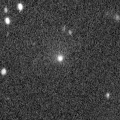
|
Very large comet. It is expected to brighten up to 13 mag in 2031. Now it is 16.6 mag (Jan. 23, ATLAS Chile). It stays 16 mag for a while. In the Northern Hemisphere, it is not observable now. In the Southern Hemisphere, it stays observable in good condition. In the Northern Hemisphere, it is not observable until 2030.
Date(TT) R.A. (2000) Decl. Delta r Elong. m1 Best Time(A, h)
Feb. 3 2 52.07 -64 6.7 16.983 16.734 73 15.9 18:56 ( 6,-10)
Feb. 10 2 52.69 -63 47.8 16.978 16.709 72 15.9 19:02 ( 10,-10)
|

|
Now it is 15.4 mag (Jan. 15, Toshihiko Ikemura, Hirohisa Sato). It will fade out rapidly after this. It will be fainter than 18 mag in April. In the Northern Hemisphere, it will be getting lower gradually. In the Southern Hemisphere, it will be unobservable in March.
Date(TT) R.A. (2000) Decl. Delta r Elong. m1 Best Time(A, h)
Feb. 3 1 26.34 9 16.2 1.889 1.809 70 15.9 18:56 ( 60, 49)
Feb. 10 1 36.30 12 36.2 1.975 1.823 66 16.1 19:02 ( 70, 47)
|

|
First return of a new periodic comet which was discovered in 2011, half a year after the perihelion passage. It is expected to brighten up to 14.5 mag in spring. Now it is 16.3 mag (Jan. 14, ATLAS-MLO, Mauna Loa). Brightening slowly. It stays observable in good condition.
Date(TT) R.A. (2000) Decl. Delta r Elong. m1 Best Time(A, h)
Feb. 3 8 21.88 10 25.0 0.753 1.730 168 16.3 23:29 ( 0, 65)
Feb. 10 8 11.66 8 34.1 0.711 1.672 159 16.0 22:51 ( 0, 63)
|
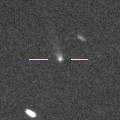
|
Now it is 16.0 mag (Jan. 1, Ken-ichi Kadota). It stays 16 mag for a while. In the Northern Hemisphere, it will be unobservable in March. In the Southern Hemisphere, it will be getting lower gradually. But it will be getting higher again after May. The brightness evolution is slower than originally expected.
Date(TT) R.A. (2000) Decl. Delta r Elong. m1 Best Time(A, h)
Feb. 3 1 41.16 -30 39.9 3.548 3.243 64 16.1 18:56 ( 28, 18)
Feb. 10 1 43.07 -30 41.2 3.593 3.207 59 16.1 19:02 ( 34, 15)
|
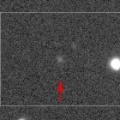
|
It will be observable at 15-16 mag from 2024 to 2025. Now it is 17.3 mag (Jan. 24, ATLAS South Africa). It stays 16 mag for a while. It stays observable in good condition.
Date(TT) R.A. (2000) Decl. Delta r Elong. m1 Best Time(A, h)
Feb. 3 13 18.76 1 34.9 3.160 3.692 115 16.2 4:29 ( 0, 56)
Feb. 10 13 19.40 1 42.8 3.054 3.676 122 16.1 4:03 ( 0, 57)
|
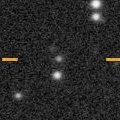
|
Now it is 16.1 mag (Jan. 29, ATLAS Chile). Fading slowly. It will be fainter than 18 mag in May. It stays observable in good condition.
Date(TT) R.A. (2000) Decl. Delta r Elong. m1 Best Time(A, h)
Feb. 3 8 56.56 -12 21.7 0.858 1.784 150 16.3 0:08 ( 0, 43)
Feb. 10 8 50.72 -13 57.8 0.849 1.772 149 16.3 23:30 ( 0, 41)
|

|
It is expected to brighten up to 13 mag in early summer. Now it is 15.9 mag (Jan. 28, ATLAS Chile). Brightening gradually. It locates somewhat low in the Northern Hemisphere. In the Southern Hemisphere, it will be getting lower gradually after this, and it will be unobservable in April. At the high light, it is not observable in the Southern Hemisphere, or it locates low in the Northern Hemisphere.
Date(TT) R.A. (2000) Decl. Delta r Elong. m1 Best Time(A, h)
Feb. 3 2 1.62 -19 56.7 2.213 2.097 70 16.4 18:56 ( 29, 30)
Feb. 10 2 3.40 -16 12.7 2.219 2.017 65 16.3 19:02 ( 39, 30)
|

|
It brightened up to 13 mag in early 2023. It stays 17 mag for a while. It stays extremely low in the Northern Hemisphere. In the Southern Hemisphere, it stays observable in good condition.
Date(TT) R.A. (2000) Decl. Delta r Elong. m1 Best Time(A, h)
Feb. 3 16 26.42 -48 5.5 4.061 3.731 63 16.4 5:31 (340, 2)
Feb. 10 16 30.72 -48 1.6 4.026 3.790 69 16.4 5:26 (342, 3)
|
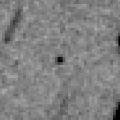
|
Now it is 15.4 mag (Jan. 31, ATLAS-MLO, Mauna Loa). Fading slowly. It will be fainter than 18 mag in May. In the Northern Hemisphere, it stays observable in good condition. It locates somewhat low in the Southern Hemisphere.
Date(TT) R.A. (2000) Decl. Delta r Elong. m1 Best Time(A, h)
Feb. 3 7 25.24 39 19.1 0.733 1.658 149 16.5 22:33 (180, 86)
Feb. 10 7 24.70 38 56.9 0.746 1.645 143 16.5 22:05 (180, 86)
|

|
Now it is 16.3 mag (Jan. 28, ATLAS-HKO, Haleakala). Fading gradually. It will be fainter than 18 mag in April. In the Northern Hemisphere, it will be getting lower gradually. In the Southern Hemisphere, it will be unobservable in March.
Date(TT) R.A. (2000) Decl. Delta r Elong. m1 Best Time(A, h)
Feb. 3 0 42.03 8 41.8 2.484 2.164 59 16.5 18:56 ( 70, 41)
Feb. 10 0 56.20 9 59.3 2.561 2.177 56 16.7 19:02 ( 75, 38)
|
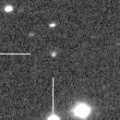
|
Now it is 16.9 mag (Jan. 20, ATLAS Chile). It stays 16 mag for a while. It locates somewhat low in the Northern Hemisphere. But it will become high in summer. In the Southern Hemisphere, it stays observable in good condition.
Date(TT) R.A. (2000) Decl. Delta r Elong. m1 Best Time(A, h)
Feb. 3 13 57.90 -28 2.7 3.206 3.447 95 16.6 5:09 ( 0, 27)
Feb. 10 14 2.95 -28 23.7 3.111 3.446 101 16.5 4:46 ( 0, 26)
|
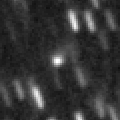
|
It stays 16 mag in the Southern sky for a long time from 2024 to 2025. It stays 16 mag for a while. It stays extremely low in the Northern Hemisphere. In the Southern Hemisphere, it stays observable in good condition.
Date(TT) R.A. (2000) Decl. Delta r Elong. m1 Best Time(A, h)
Feb. 3 16 55.36 -44 37.8 6.324 5.868 58 16.7 5:31 (333, 3)
Feb. 10 16 55.42 -45 16.7 6.195 5.844 64 16.6 5:26 (337, 4)
|

|
It is expected to brighten up to 15.5 mag from March to April. Now it is 16.9 mag (Jan. 27, ATLAS-HKO, Haleakala). Brightening slowly. It locates somewhat low in the Northern Hemisphere. But it will become high in spring. In the Southern Hemisphere, it stays observable in good condition.
Date(TT) R.A. (2000) Decl. Delta r Elong. m1 Best Time(A, h)
Feb. 3 16 49.26 -14 24.0 1.783 1.562 60 17.0 5:31 (318, 29)
Feb. 10 17 11.46 -14 32.3 1.732 1.549 62 16.7 5:26 (318, 29)
|

|
Now it is 17.0 mag (Jan. 9, Toshihiko Ikemura, Hirohisa Sato). It stays 17 mag for a while. It will be unobservable in May.
Date(TT) R.A. (2000) Decl. Delta r Elong. m1 Best Time(A, h)
Feb. 3 4 34.22 30 24.1 4.484 5.019 117 16.8 19:43 ( 0, 85)
Feb. 10 4 35.16 29 44.2 4.567 5.005 110 16.8 19:16 ( 0, 85)
|
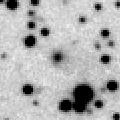
|
Now it is 17.3 mag (Jan. 28, Thomas Lehmann). It stays 17 mag for a while. In the Northern Hemisphere, it stays observable in good condition. In the Southern Hemisphere, it will be unobservable in April.
Date(TT) R.A. (2000) Decl. Delta r Elong. m1 Best Time(A, h)
Feb. 3 4 31.80 40 27.4 6.179 6.693 117 16.8 19:41 (180, 85)
Feb. 10 4 32.49 40 13.9 6.276 6.694 111 16.8 19:14 (180, 85)
|
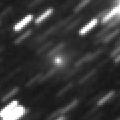
|
Very far object. Now it is 16.9 mag (Jan. 15, ATLAS Chile). It stays 17 mag for a while. In the Northern Hemisphere, it is not observable now. In the Southern Hemisphere, it stays observable in good condition.
Date(TT) R.A. (2000) Decl. Delta r Elong. m1 Best Time(A, h)
Feb. 3 2 13.33 -70 55.0 10.616 10.322 70 16.8 18:56 ( 8,-17)
Feb. 10 2 12.17 -70 4.9 10.627 10.323 69 16.8 19:02 ( 11,-18)
|
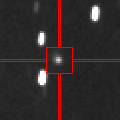
|
Now it is 16.5 mag (Jan. 25, ATLAS Chile). It stays 17 mag for a while. In the Northern Hemisphere, it will be unobservable in April. In the Southern Hemisphere, it stays observable in good condition.
Date(TT) R.A. (2000) Decl. Delta r Elong. m1 Best Time(A, h)
Feb. 3 4 45.79 -37 23.3 7.366 7.581 98 17.0 19:54 ( 0, 18)
Feb. 10 4 45.74 -36 35.5 7.398 7.558 95 17.0 19:26 ( 0, 19)
|
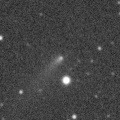
|
It brightened very rapidly up to 14.9 mag in early summer (July 13, Taras Prystavski). Now it is 17.2 mag (Jan. 16, Ken-ichi Kadota). Fading gradually. It will be fainter than 18 mag in April. In the Northern Hemisphere, it stays observable in good condition. In the Southern Hemisphere, it will be getting lower gradually.
Date(TT) R.A. (2000) Decl. Delta r Elong. m1 Best Time(A, h)
Feb. 3 14 58.38 10 1.3 2.423 2.679 93 17.1 5:31 (339, 63)
Feb. 10 14 53.22 13 27.6 2.343 2.730 102 17.1 5:26 (353, 68)
|
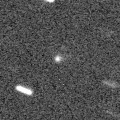
|
Now it is 17.3 mag (Jan. 15, ATLAS-HKO, Haleakala). It stays 17 mag for a while. It will be unobservable in May.
Date(TT) R.A. (2000) Decl. Delta r Elong. m1 Best Time(A, h)
Feb. 3 1 49.03 3 31.7 2.569 2.475 73 17.2 18:56 ( 48, 49)
Feb. 10 1 56.86 4 37.7 2.620 2.439 68 17.1 19:02 ( 56, 45)
|
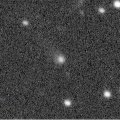
|
Now it is 17.6 mag (Jan. 22, Jean-Claude Merlin). It stays 18 mag for a while. In the Northern Hemisphere, it will never be observable after this. In the Southern Hemisphere, it stays observable in good condition.
Date(TT) R.A. (2000) Decl. Delta r Elong. m1 Best Time(A, h)
Feb. 3 5 59.56 -72 22.9 3.818 3.872 85 17.3 21:04 ( 0,-17)
Feb. 10 5 31.39 -71 34.2 3.850 3.890 84 17.3 20:09 ( 0,-16)
|

|
Now it is 17.5 mag (Jan. 29, D. Buczynski). It stays 18 mag for a while. It stays observable in good condition.
Date(TT) R.A. (2000) Decl. Delta r Elong. m1 Best Time(A, h)
Feb. 3 6 49.23 18 18.1 1.570 2.462 148 17.3 21:57 ( 0, 73)
Feb. 10 6 46.68 19 9.0 1.609 2.452 140 17.3 21:27 ( 0, 74)
|

|
Now it is 17.3 mag (Jan. 27, ATLAS-HKO, Haleakala). It stays 17 mag for a while. It stays observable in good condition.
Date(TT) R.A. (2000) Decl. Delta r Elong. m1 Best Time(A, h)
Feb. 3 7 55.18 -9 32.2 3.883 4.753 148 17.4 23:03 ( 0, 45)
Feb. 10 7 51.86 -9 27.5 3.868 4.714 145 17.4 22:32 ( 0, 45)
|
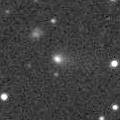
|
Now it is 16.7 mag (Jan. 30, ATLAS Chile). Fading slowly. It will be fainter than 18 mag in March. It will be getting lower gradually.
Date(TT) R.A. (2000) Decl. Delta r Elong. m1 Best Time(A, h)
Feb. 3 3 24.91 7 40.1 3.033 3.308 97 17.4 18:56 ( 12, 62)
Feb. 10 3 28.98 8 20.7 3.147 3.324 91 17.5 19:02 ( 27, 61)
|
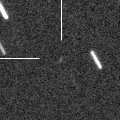
|
Now it is 17.0 mag (Jan. 27, ATLAS South Africa). Fading gradually. It will be fainter than 18 mag in March. It locates somewhat low in the Northern Hemisphere. In the Southern Hemisphere, it stays observable in good condition.
Date(TT) R.A. (2000) Decl. Delta r Elong. m1 Best Time(A, h)
Feb. 3 9 35.27 -33 25.9 1.573 2.325 129 17.4 0:48 ( 0, 22)
Feb. 10 9 5.77 -35 14.5 1.606 2.362 129 17.5 23:43 ( 0, 20)
|
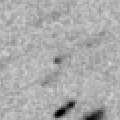
|
Now it is 17.4 mag (Jan. 10, ATLAS Chile). Fading gradually. It will be fainter than 18 mag in March. It stays observable in good condition.
Date(TT) R.A. (2000) Decl. Delta r Elong. m1 Best Time(A, h)
Feb. 3 12 16.26 3 0.1 1.361 2.138 130 17.5 3:27 ( 0, 58)
Feb. 10 12 16.39 2 28.4 1.311 2.144 137 17.5 3:00 ( 0, 57)
|

|
It approached to Earth down to 0.29 a.u. in early last February, and it brightened up to 4.5 mag (Feb. 1, Juan Jose Gonzalez). Now it is 19.2 mag (Jan. 12, ATLAS South Africa). Fading slowly. It will be fainter than 18 mag in March. In the Northern Hemisphere, it will never be observable after this. In the Southern Hemisphere, it stays observable in good condition.
Date(TT) R.A. (2000) Decl. Delta r Elong. m1 Best Time(A, h)
Feb. 3 3 2.43 -55 38.9 5.105 4.961 76 17.5 18:56 ( 6, -1)
Feb. 10 3 0.59 -54 28.8 5.215 5.028 73 17.6 19:02 ( 12, -1)
|

|
It brightened up to 14.1 mag in 2022 spring (Mar. 22, 2022, Chris Wyatt). Now it is 17.2 mag (Jan. 13, ATLAS-MLO, Mauna Loa). It stays 18 mag for a while. It will be unobservable in March.
Date(TT) R.A. (2000) Decl. Delta r Elong. m1 Best Time(A, h)
Feb. 3 1 16.83 3 26.3 6.510 6.172 65 17.5 18:56 ( 57, 43)
Feb. 10 1 17.83 4 3.5 6.667 6.220 59 17.6 19:02 ( 65, 38)
|
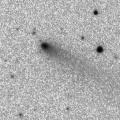
|
Now it is 16.9 mag (Jan. 22, ATLAS-MLO, Mauna Loa). It stays 18 mag for a while. It locates somewhat low in the Northern Hemisphere. In the Southern Hemisphere, it will be unobservable in March. It is brighter than this ephemeris recently.
Date(TT) R.A. (2000) Decl. Delta r Elong. m1 Best Time(A, h)
Feb. 3 0 38.73 -1 6.9 4.437 3.960 55 17.5 18:56 ( 61, 33)
Feb. 10 0 44.76 -0 16.6 4.538 3.976 49 17.6 19:02 ( 67, 29)
|
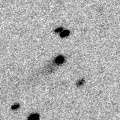
|
Now it is 17.3 mag (Jan. 20, ATLAS-HKO, Haleakala). It stays 18 mag for a while. It stays observable in good condition.
Date(TT) R.A. (2000) Decl. Delta r Elong. m1 Best Time(A, h)
Feb. 3 12 20.61 16 41.5 8.709 9.407 132 17.5 3:32 ( 0, 72)
Feb. 10 12 17.26 17 15.8 8.643 9.421 140 17.5 3:01 ( 0, 72)
|

|
Now it is 17.7 mag (Jan. 11, Ken-ichi Kadota). It stays 17 mag for a while. It locates somewhat low in the Northern Hemisphere. In the Southern Hemisphere, it stays observable in good condition.
Date(TT) R.A. (2000) Decl. Delta r Elong. m1 Best Time(A, h)
Feb. 3 15 26.90 -27 17.2 3.257 3.187 77 17.6 5:31 (344, 26)
Feb. 10 15 34.28 -27 47.9 3.157 3.183 82 17.5 5:26 (347, 26)
|

|
Now it is 17.3 mag (Jan. 22, ATLAS-HKO, Haleakala). Fading gradually. It will be fainter than 18 mag soon. In the Northern Hemisphere, it stays observable in good condition. In the Southern Hemisphere, it will never be observable after this.
Date(TT) R.A. (2000) Decl. Delta r Elong. m1 Best Time(A, h)
Feb. 3 3 18.61 69 8.4 1.542 2.060 107 17.6 18:56 (176, 56)
Feb. 10 3 54.06 65 54.5 1.586 2.082 105 17.7 19:02 (175, 59)
|

|
Now it is 17.7 mag (Jan. 31, ATLAS-HKO, Haleakala). It stays 17 mag for a while. It stays observable in good condition.
Date(TT) R.A. (2000) Decl. Delta r Elong. m1 Best Time(A, h)
Feb. 3 10 58.45 2 20.4 5.102 5.962 148 17.7 2:10 ( 0, 57)
Feb. 10 10 54.65 3 24.5 5.007 5.925 156 17.6 1:38 ( 0, 58)
|
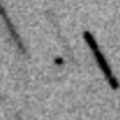
|
Now it is 18.0 mag (Jan. 14, Toshihiko Ikemura, Hirohisa Sato). It will brighten rapidly after this. In the Northern Hemisphere, it will be getting lower gradually after this, and it will be unobservable in April. In the Southern Hemisphere, it will be getting lower gradually. It will brighten up to 11 mag in summer. But it is not observable at the high light.
Date(TT) R.A. (2000) Decl. Delta r Elong. m1 Best Time(A, h)
Feb. 3 2 15.06 -7 54.9 3.081 3.004 76 17.7 18:56 ( 31, 42)
Feb. 10 2 18.48 -7 17.3 3.097 2.922 70 17.6 19:02 ( 40, 39)
|

|
Now it is 17.8 mag (Jan. 19, ATLAS Chile). It stays 17 mag for a while. In the Northern Hemisphere, it is not observable now, but it will appear in March. In the Southern Hemisphere, it stays observable in good condition. It stays 15 mag for a long time from late 2024 to early 2026.
Date(TT) R.A. (2000) Decl. Delta r Elong. m1 Best Time(A, h)
Feb. 3 6 22.66 -61 51.2 5.520 5.694 95 17.8 21:29 ( 0, -7)
Feb. 10 6 15.86 -60 28.5 5.476 5.654 95 17.7 20:55 ( 0, -5)
|
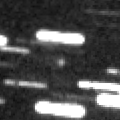
|
Now it is 18.5 mag (Jan. 29, Yasukazu Ikari). It stays 18 mag for a while. It stays observable in good condition.
Date(TT) R.A. (2000) Decl. Delta r Elong. m1 Best Time(A, h)
Feb. 3 6 27.11 9 15.1 6.976 7.770 141 17.7 21:35 ( 0, 64)
Feb. 10 6 22.10 9 19.0 7.060 7.772 133 17.8 21:02 ( 0, 64)
|
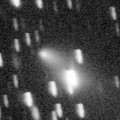
|
It brightened up to 13.6 mag in summer (July 16, Mitsunori Tsumura). Now it is 17.1 mag (Jan. 10, Thomas Lehmann). Fading gradually. It will be fainter than 18 mag soon. In the Northern Hemisphere, it stays observable in good condition. In the Southern Hemisphere, it will never be observable after this.
Date(TT) R.A. (2000) Decl. Delta r Elong. m1 Best Time(A, h)
Feb. 3 0 58.31 62 52.1 2.540 2.754 91 17.8 18:56 (150, 52)
Feb. 10 1 16.50 62 50.2 2.643 2.803 88 18.0 19:02 (149, 50)
|
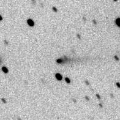
|
Now it is 17.2 mag (Jan. 19, ATLAS-HKO, Haleakala). Fading slowly. It will be fainter than 18 mag soon. It stays observable in good condition.
Date(TT) R.A. (2000) Decl. Delta r Elong. m1 Best Time(A, h)
Feb. 3 8 30.37 -3 24.5 3.166 4.098 158 17.8 23:38 ( 0, 52)
Feb. 10 8 26.46 -2 50.7 3.191 4.113 156 17.9 23:06 ( 0, 52)
|
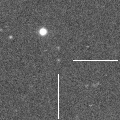
|
Far asteroid moving along a cometary orbit. It brightens up to 18 mag from 2024 to 2025. It stays 18 mag for a while. In the Northern Hemisphere, it stays observable in good condition. It stays extremely low in the Southern Hemisphere.
Date(TT) R.A. (2000) Decl. Delta r Elong. m1 Best Time(A, h)
Feb. 3 8 23.25 50 53.1 7.953 8.778 145 17.9 23:31 (180, 74)
Feb. 10 8 15.89 50 42.5 7.987 8.775 140 17.9 22:56 (180, 74)
|
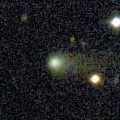
|
It brightened up to 13.9 mag in early 2023 (Jan. 21, Hidenori Nohara). Now it is 19.1 mag (Jan. 11, Toshihiko Ikemura, Hirohisa Sato). It stays 18 mag for a while. It stays observable in good condition.
Date(TT) R.A. (2000) Decl. Delta r Elong. m1 Best Time(A, h)
Feb. 3 14 40.03 7 10.2 4.452 4.685 97 17.9 5:31 (350, 62)
Feb. 10 14 42.37 7 31.5 4.396 4.727 103 17.9 5:25 ( 0, 62)
|
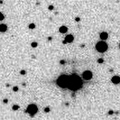
|
Now it is 18.9 mag (Jan. 13, ATLAS-MLO, Mauna Loa). It stays 18 mag for a while. It stays observable in good condition.
Date(TT) R.A. (2000) Decl. Delta r Elong. m1 Best Time(A, h)
Feb. 3 10 5.95 13 11.3 3.297 4.254 164 17.9 1:17 ( 0, 68)
Feb. 10 10 1.97 13 31.0 3.284 4.264 172 17.9 0:46 ( 0, 68)
|
|
![]()
 C/2021 G2 ( ATLAS )
C/2021 G2 ( ATLAS ) C/2021 T4 ( Lemmon )
C/2021 T4 ( Lemmon ) 13P/Olbers
13P/Olbers C/2019 L3 ( ATLAS )
C/2019 L3 ( ATLAS ) 32P/Comas Sola
32P/Comas Sola C/2023 H2 ( Lemmon )
C/2023 H2 ( Lemmon ) C/2020 K1 ( PanSTARRS )
C/2020 K1 ( PanSTARRS ) C/2023 P1 ( Nishimura )
C/2023 P1 ( Nishimura ) C/2019 T4 ( ATLAS )
C/2019 T4 ( ATLAS ) C/2023 C2 ( ATLAS )
C/2023 C2 ( ATLAS ) C/2022 QE78 ( ATLAS )
C/2022 QE78 ( ATLAS ) C/2014 UN271 ( Bernardinelli-Bernstein )
C/2014 UN271 ( Bernardinelli-Bernstein ) 226P/Pigott-LINEAR-Kowalski
226P/Pigott-LINEAR-Kowalski P/2023 WM26 ( Elenin )
P/2023 WM26 ( Elenin ) C/2022 S4 ( Lemmon )
C/2022 S4 ( Lemmon ) 65P/Gunn
65P/Gunn 150P/LONEOS
150P/LONEOS C/2023 V4 ( Camarasa-Duszanowicz )
C/2023 V4 ( Camarasa-Duszanowicz ) C/2021 Y1 ( ATLAS )
C/2021 Y1 ( ATLAS ) 227P/Catalina-LINEAR
227P/Catalina-LINEAR 471P/2023 KF3
471P/2023 KF3 C/2022 T1 ( Lemmon )
C/2022 T1 ( Lemmon ) C/2023 F3 ( ATLAS )
C/2023 F3 ( ATLAS ) 125P/Spacewatch
125P/Spacewatch C/2022 U3 ( Bok )
C/2022 U3 ( Bok ) C/2021 S4 ( Tsuchinshan )
C/2021 S4 ( Tsuchinshan ) C/2019 E3 ( ATLAS )
C/2019 E3 ( ATLAS ) C/2022 R6 ( PanSTARRS )
C/2022 R6 ( PanSTARRS ) C/2023 K1 ( ATLAS )
C/2023 K1 ( ATLAS ) 30P/Reinmuth 1
30P/Reinmuth 1 C/2022 A3 ( Lemmon-ATLAS )
C/2022 A3 ( Lemmon-ATLAS ) P/2023 Y3 ( ATLAS )
P/2023 Y3 ( ATLAS ) C/2023 T3 ( Fuls )
C/2023 T3 ( Fuls ) 170P/Christensen
170P/Christensen C/2022 V2 ( Lemmon )
C/2022 V2 ( Lemmon ) 216P/LINEAR
216P/LINEAR C/2022 E3 ( ZTF )
C/2022 E3 ( ZTF ) C/2020 Y2 ( ATLAS )
C/2020 Y2 ( ATLAS ) 117P/Helin-Roman-Alu 1
117P/Helin-Roman-Alu 1 C/2020 F2 ( ATLAS )
C/2020 F2 ( ATLAS ) 299P/Catalina-PanSTARRS
299P/Catalina-PanSTARRS C/2023 T2 ( Borisov )
C/2023 T2 ( Borisov ) C/2023 H5 ( Lemmon )
C/2023 H5 ( Lemmon ) C/2023 R2 ( PanSTARRS )
C/2023 R2 ( PanSTARRS ) C/2024 A1 ( ATLAS )
C/2024 A1 ( ATLAS ) C/2021 A9 ( PanSTARRS )
C/2021 A9 ( PanSTARRS ) 126P/IRAS
126P/IRAS 408P/2020 M7 ( Novichonok-Gerke )
408P/2020 M7 ( Novichonok-Gerke ) (468861) 2013 LU28
(468861) 2013 LU28 C/2020 S4 ( PanSTARRS )
C/2020 S4 ( PanSTARRS ) 244P/Scotti
244P/Scotti![]()





























































